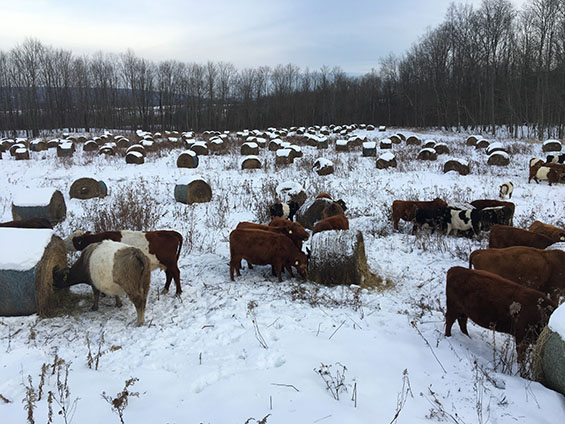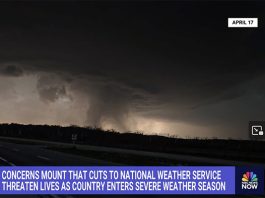If you’re outwintering cattle, you have many options for providing the forage they need. In addition to grazing stockpiled pasture, I have tried bale grazing and unrolling hay. I have found all three methods to be useful in different situations.
Preparing for Winter
 Before switching to seasonal heifer development, I used to outwinter a custom cow-calf herd in New York State. Every summer, I bought all of my hay. I had all hay tested that I was considering buying, to ensure quality. I wasn’t buying dairy-quality forage, just first cutting grass hay, but I wanted to make sure it would support my pregnant cows and the calves I wintered on them. The hay I bought tested 8-12% crude protein, 55+ percent total digestible nutrients (TDN) and 75+ relative feed value (RFV). In addition to hay, my herd had access to free choice cafeteria style mineral and some stockpile in feeding areas.
Before switching to seasonal heifer development, I used to outwinter a custom cow-calf herd in New York State. Every summer, I bought all of my hay. I had all hay tested that I was considering buying, to ensure quality. I wasn’t buying dairy-quality forage, just first cutting grass hay, but I wanted to make sure it would support my pregnant cows and the calves I wintered on them. The hay I bought tested 8-12% crude protein, 55+ percent total digestible nutrients (TDN) and 75+ relative feed value (RFV). In addition to hay, my herd had access to free choice cafeteria style mineral and some stockpile in feeding areas.
I made sure to get my hay delivered and placed before fall set in and the rain and snow came. The high precipitation and heavy clay soils on my farm meant that I had only a 2-month window each year during which trucks could be driven in the pastures. I had the hay trucks drive to a poor area of the pasture that offered adequate wind protection. I borrowed my landlord’s tractor to unload the hay and place it in a checkerboard pattern for bale grazing. Bales were spaced on 10-15 foot circles to allow for animal movement and for placing polywires between them. I only bought net-wrapped hay, because net wrap results in less rotting when hay is stored outdoors. I unwrapped hay at feeding time, which was sometimes difficult because of snow and ice.

Stockpiled Pasture
My stockpiled forage could be depended on to feed the herd until sometime in December. My goal was to feed hay only when snow cover prevented stockpile grazing, or after I ran out of stockpile. If snow cut my stockpile grazing short, and then melted off sometime in January or February, I turned the cattle back out on the remaining unused stockpile. Just because I started feeding hay didn’t mean I was committed to doing it every day until April.
In the Northeast, stockpiled forage sometimes doesn’t make it through the winter well. Heavy, wet snow mats it to the ground and it begins to decay. This is excellent for soil health, but doesn’t leave much for cattle to eat that has any nutritional value. This doesn’t mean it can’t be done though. Some grass species, like tall fescue, stockpile a lot better than others. Troy Bishopp, a Madison County New York grazier, showed forage test results on stockpile that rival spring grass. The 160-day old orchardgrass stockpile from his December 2014 pastures tested 19% crude protein and 60% TDN.

Bale Grazing
For bale grazing, I let the cattle into 3-6 bales at a time (using colored polywire and posts for visibility against snow). I wanted them to have enough feeding sites so that the dominant and larger cattle couldn’t keep the calves and submissive cattle from getting enough to eat. As the number of bales given at one time increases, so does the amount of hay fouled and uneaten. I fed the herd every few days to reach a happy medium between these factors. The bale grazing area did get pretty muddy when temperatures were above freezing, but the cattle bedded in the half-eaten bales. This kept udders clean, and I didn’t have any sick cows or calves all winter.
I wanted to push my cattle to clean up as much of the hay as possible, but not to limit them nutritionally. Over the course of a whole winter, stretching each set of bales one extra day can make your hay supply last weeks longer than expected. This can save you a huge amount of money. Keep a close eye on the rumen fill and body condition scores of your cattle. If they begin to lose weight and/or you’re seeing sunken, empty rumens, you’re limiting them.
Unrolling Hay
In the winter of 2016-2017, I bale grazed the cowherd on a poor area in my pasture and only unrolled a couple bales in fall or spring. The following winter, I tried to unroll the hay on poor areas whenever weather permitted. When snow got too deep for my ATV and unroller trailer to get around, I sectioned off some bales with polywire and let the cattle bale graze them right where they had been unloaded from the delivery trucks.
Unrolling worked really well when the ground was dry or frozen. The cattle had plenty of room to eat without crowding, and more hay was consumed instead of being fouled in a pile. But, when there was mud or temperatures were above freezing, bale grazing did not work well at all. Within an hour or two after putting the bale out, the cattle had stomped most of it into the mud before they could even eat it. Getting enough hay into the cattle became a very expensive proposition. I had to unroll every day because hay would get weathered, snowed over or trampled quickly. Unrolling also covered my ATV with mud as I fought through it to move hay. The increased fuel costs and repairs made it more expensive to winter the herd. I had hoped that keeping cattle moving all winter instead of parked in one bale-grazing location would result in less mud, but that didn’t turn out to be true. I saw better soil-building results and pasture improvement in bale grazing spots than in unrolling swaths.
The bale unroller I used is designed by Greg Judy. He now manufactures them for sale. Click here to learn more about them, and how you can get your own.

Your Results Will Vary
Of course, depending on your location, how bale grazing, bale unrolling and stockpiling works for you will be different. I am now in Oklahoma on a 25,000-acre ranching operation. We are wintering over 1,500 head of cattle, including fall pairs, pregnant dry cows, and weaned spring-born calves. Snow hardly ever accumulates enough to affect our feeding routine. Our cattle come through the winter on stockpiled pasture with some range cubes (“cake”) for protein. We unroll all our hay, which is used only as a supplement for growing stock and during challenging weather. The ground stays hard and dry enough all year to unroll with a pickup truck, which wasn’t possible in New York. There is hardly ever any mud, so almost all unrolled hay makes it into the mouths of cattle. The pasture improvement from unrolling here comes from the animal impact of the herd, not so much from the uneaten hay.
Whenever possible, grazing stockpiled forage is the easiest way to feed your herd through winter. My recommendation is to unroll hay in dry and mud-free conditions, but to bale graze in deep snow and wet weather. If you live in a climate with wet, muddy, long winters, a summer-only grazing operation might be your easiest and most profitable option. Check out my past On Pasture articles for more about how I went seasonal to avoid winter headaches and expenses.





Thanks for this interesting article regarding information on cattle. We appreciate having reliable and up-to-date facts in the farming world. Keep up the good work!
Thanks Meg, for the shout out. Happy New Year. You have inspired me to tell others about my variable wintering experience.
Comments are closed.